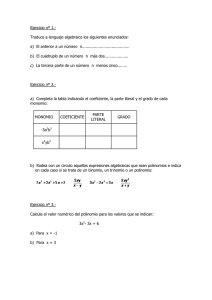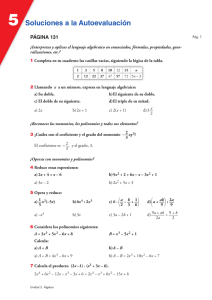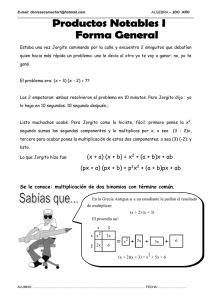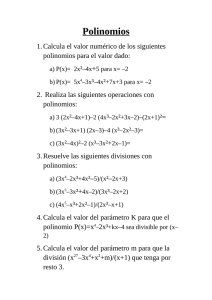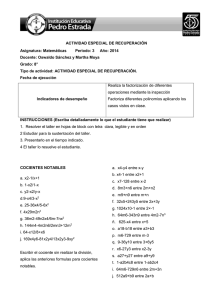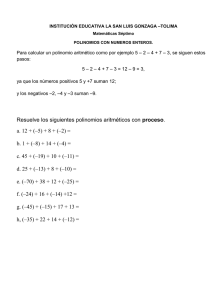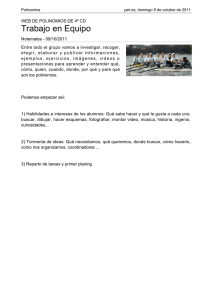1.- Rodea, en cada caso, los monomios semejantes:
Anuncio
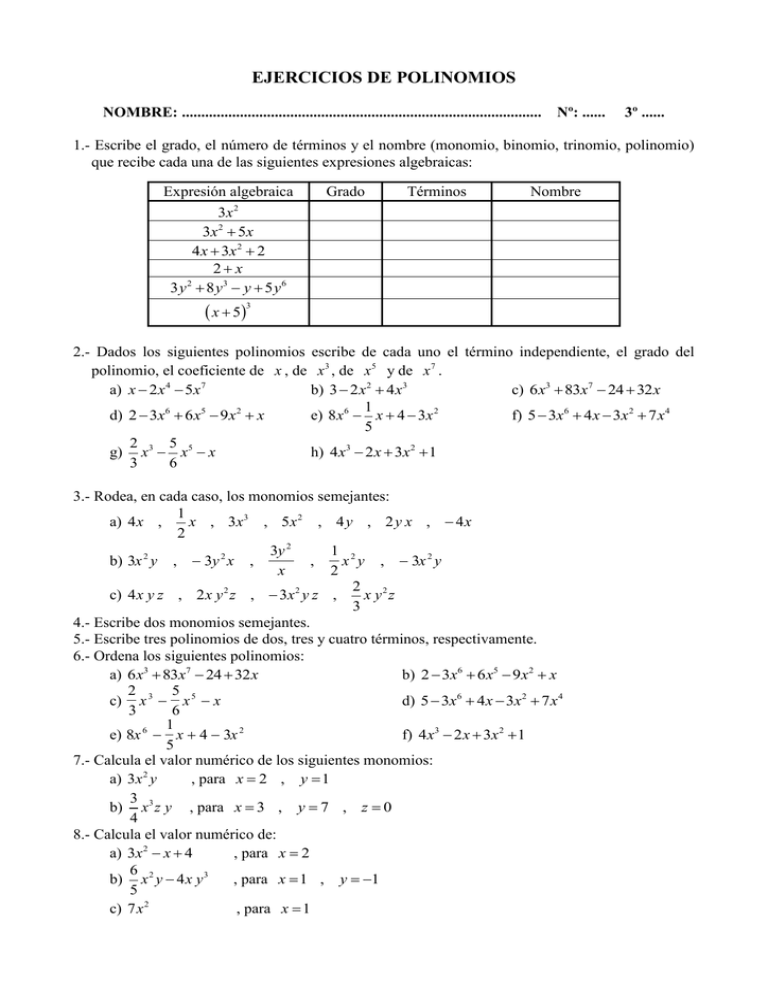
EJERCICIOS DE POLINOMIOS NOMBRE: ............................................................................................. Nº: ...... 3º ...... 1.- Escribe el grado, el número de términos y el nombre (monomio, binomio, trinomio, polinomio) que recibe cada una de las siguientes expresiones algebraicas: Expresión algebraica 3x 2 3x 2 5 x 4 x 3x 2 2 2 x 2 3 y 8 y3 y 5 y 6 x 5 Grado Términos Nombre 3 2.- Dados los siguientes polinomios escribe de cada uno el término independiente, el grado del polinomio, el coeficiente de x , de x 3 , de x 5 y de x 7 . a) x 2 x 4 5x7 b) 3 2 x2 4 x3 c) 6 x3 83x7 24 32 x 1 d) 2 3x6 6 x5 9 x2 x e) 8 x 6 x 4 3x 2 f) 5 3x6 4 x 3x2 7 x4 5 2 3 5 5 g) x x x h) 4 x3 2 x 3x2 1 3 6 3.- Rodea, en cada caso, los monomios semejantes: 1 a) 4 x , x , 3x3 , 5 x 2 , 4 y , 2 y x , 4 x 2 3y 2 1 2 , x y , 3x 2 y b) 3x 2 y , 3y 2 x , x 2 2 2 c) 4 x y z , 2 x y 2 z , 3x 2 y z , xy z 3 4.- Escribe dos monomios semejantes. 5.- Escribe tres polinomios de dos, tres y cuatro términos, respectivamente. 6.- Ordena los siguientes polinomios: a) 6 x3 83x7 24 32 x b) 2 3x6 6 x5 9 x2 x 2 5 c) x 3 x 5 x d) 5 3x6 4 x 3x2 7 x4 3 6 1 e) 8x 6 x 4 3x 2 f) 4 x3 2 x 3x2 1 5 7.- Calcula el valor numérico de los siguientes monomios: a) 3x 2 y , para x 2 , y 1 3 b) x3 z y , para x 3 , y 7 , z 0 4 8.- Calcula el valor numérico de: a) 3x2 x 4 , para x 2 6 b) x 2 y 4 x y 3 , para x 1 , y 1 5 c) 7x 2 , para x 1 d) 8x3 y 2 z , para x 1 , y 4 , z 2 2 e) 2 x 3x 1 , para x 2 3 f) 7 x 2 x 5 , para x 3 9.- Efectúa la suma de los siguientes monomios: a) x x b) 3x2 5x2 6 x2 c) 6 x 7 x 2 x 7 x 2 x 1 5 3 d) x3 x3 x3 e) 4 x2 y 5x 2 y 7 x 2 y 8x 2 y 2 2 2 1 1 3 3 f) x y z 4 x y z x y z x y z g) x 2 4 x 2 11x 2 3 6 2 2 1 2 1 2 2 h) x ( x) x 3x i) a b 3 a 2b a 2b 2 4 2 3 10.- Calcula los siguientes productos de monomios: a) x · x b) 3x ·2 x c) 4 x 2 ·5 x d) 7 x 2 ·3x 2 1 7 1 e) 4 x y ·2 x 2 y f) g) x 2 y ·3x y h) x 4 ·2 x 2 · x ab ·ab 3 9 3 2 5 1 i) x y z · x 2 y z 3 · x y z j) x 2 ·2 x 2 · x3 k) x y 2 z ·3x y z ·4 x 2 y z 5 3 3 11.- Efectúa la división de los monomios y simplifica el resultado siempre que sea posible: 18x 5 y 6 4x 7 y 2 3x 2 7x8 6 x9 a) b) 3 c) 2 d) e) 3x 2 y 2 xy x x 3x 12 a 2b 6 x8 y 3 z g) a 2b 3 y 2 z 2 x4 12.- Calcula las siguientes potencias: f) h) 4 3 2 1 2 2 a bx : x a 5 5 a) x 2 b) 3x 2 c) 4x3 y 2 e) x y z f) 2x 2 y g) 5x 2 i) 2x j) 3a b2 x3 3 6 3 2 3 3 7 i) 7 3 2 x y a : 3 x y3 9 2 d) 3x 2 y 5 h) 3x 4 y 0 1 2 13.- Calcula y simplifica: 3 a) 3x5 2 b) 4 x 2 y · 3x y 2 · 2 x y c) 15 x5b3c3 5 x 2b c 14.- Calcula lo que se pide en cada caso: P( x ) 6 x 4 4 x 2 x 7 Q( x) 2 x 4 x3 x 2 1 R( x ) 3 7 x x 3 a) P( x) Q( x) b) Q( x) R( x) c) P( x) Q( x) d) Q( x) R( x) 15.- Calcula: a) x3 5x3 4 x3 6 x3 b) 4 x2 7 x4 3 8x4 2 5x2 Q( x) 4 x 2 , R( x) 3x 2 x . Calcula: 16.- Siendo P( x) 3x2 x 1 , a) P( x) · Q( x) b) Q( x) · R( x) c) P( x) · R( x) 2 4 5 2 17.- Siendo P( x) 5 3x 6 x 7 x , Q( x) 3x 2 x 2 , R( x) x3 3x 2 . Calcula: a) P( x) Q( x) R( x) y comprueba que coincide con P( x) Q( x) R( x) b) Q( x) · R( x) y comprueba que coincide con R( x) · Q( x) c) R( x) 2 18.- Dados los polinomios siguientes: P( x) 2 x4 3x2 2 , Efectuar las operaciones: a) R( x) · P( x) Q( x) Q( x) x4 x3 2 x2 , b) R( x) · P( x) R( x) · Q( x) 19.- Calcula las expresiones siguientes: a) 3x3 5 x 2 b) 4 x 2 x 4 d) x 5 x 2 e) x 2 1 · x 2 1 2 2 R( x) x3 3x c) 4 x 3x3 · 4 x 3x3 2 20.- Expresa, siempre que sea posible, en forma de potencia de un binomio: a) x4 4 x2 4 b) x2 8x 16 c) 4 x2 4 x 1 d) x2 10 x 25 e) 9 6x x2 f) 4 x2 12 x 9 g) 4 x4 12 x2 9 h) 9 x2 12 x y 4 y 2 i) 2 y3 y 6 1 j) x2 2 x 1 k) 9 x4 12 x2 1 l) a 2 4 a b 4 b2 1 1 3 9 m) 2 x 2 2 x n) x 2 x ñ) x 2 x 4 4 2 16 o) 3x2 6 x 3 p) x2 x 0'25 q) x2 2 x 1 r) 8x3 12 x2 y 6 x y 2 y3 21.- Completar los siguientes polinomios para obtener el cuadrado de un binomio y di de qué cuadrado se trata, siempre que sea posible: 2 2 a) x 2 4 x .......... .......... .......... b) x6 6 x3 .......... .......... .......... c) x 2 12 x .......... x .......... d) x4 48x2 .......... .......... .......... 2 e) a 2 x2 2a b x .......... .......... .......... g) x 2 .......... 4 .......... .......... k) x 2 .......... .......... .......... 1 2 m) 4 x 2 2 x .......... .......... .......... 2 j) .......... 4 x .......... x .......... 2 2 l) 4 x 2 4 x .......... .......... .......... 2 ñ) x 2 1 .......... .......... .......... f) x 2 6 x 9 .......... .......... h) x 2 12 x .......... x .......... 2 i) 9 x2 6 x .......... .......... .......... 2 2 2 2 n) 5x4 10 x2 .......... .......... .......... 2 2 22.- Escribir como producto de dos factores (suma por diferencia): a) 4 x2 16 b) 9 x 2 4 c) a6 x2 d) x 2 9 e) x4 x2 1 f) x 2 g) 4 x 2 9 y 2 h) 25x 2 36 y 2 i) x 4 y 4 4 23.- Hallar: 3 7 2 5 x : x a) 2 x5 : 2 x3 b) 5x6 : 2 x3 c) 4 5 4 3 2 6 4 2 d) 5x 2 x 6 x 5 : 3x e) 8x 6 x 12 x 2 x 8 : 2 x f) 6 x5 6 x 2 8x 6 : 2 x g) x 4 3x3 3x 2 6 x 8 : x 1 24.- Aplica la Regla de Ruffini para calcular el cociente y el resto de las siguientes divisiones: P( x ) 2 x 4 3 x 3 2 x 1 a) P( x) : ( x 1) b) P( x) : ( x 1) c) P( x) : ( x 2) d) P( x) : ( x 2) 25.- Calcular por la Regla de Ruffini: a) x3 2 x 5 : x 1 b) 3x5 2 x 2 3x 6 : x 3 c) 2 x4 x3 x 2 5x 5 : x 3 d) 3x 4 x 2 x : x 1 g) x3 5x 4 : x 4 h) x3 53 : x 5 e) 2 x5 x3 x 2 x : x 1 i) 2 x5 x 2 x : x 3 k) 3x5 x 2 x 1 : x 2 m) 2 x3 6 x 1 : x 2 ñ) x 4 x3 x 2 x 1 : x 1 p) 5x 4 3x3 6 x 2 2 x 6 : x 1 f) x 4 2 x3 1 : x 1 j) x3 33 : x 3 l) x 4 24 : x 2 n) x6 26 : x 2 o) 3x 2 4 x 3 : x 3 q) 2 x3 x 2 7 x 3 : x 2 26.- Efectuar los siguientes cocientes por el método más corto: a) 2 x5 3x3 2 x 2 5x 1 : 2 x 2 1 b) 2 x 4 3x3 2 x 3 : x 1 c) 5x5 3x3 4 x 2 4 x 2 : x 2 2 x 3 d) x 4 x3 x 2 x : x 2 g) 2 x5 6 x3 2 x 2 5x 6 : 3x 2 x 2 h) x 4 2 x : 2 x 1 e) 4 x 4 3x3 6 x 2 2 x 5 : x 2 x i) 12 x3 10 x 4 4 x : 2 x f) x 4 3x3 x 5 : x 2 27.- Dados los polinomios P( x) 2 x 4 3x 2 2 , Q( x) x 2 5x 7 , realiza las siguientes operaciones: a) P( x) Q( x) b) P( x) · Q( x) c) P( x) : Q( x) 28.- Dados los polinomios P( x) 2 x 7 , Q( x) 2 x3 3x 2 12 , R( x) 2 x3 3x 5 , S ( x) x 2 x 2 , calcula los polinomios: a) P( x) Q( x) b) P( x) R( x) c) R( x) S ( x) Q( x) d) Q( x) · S ( x) e) Q( x) : P( x) f) R( x) : S ( x) 29.- Hallar las raíces enteras de los siguientes polinomios: a) 3x3 3x2 17 x 2 b) x4 6 x3 7 x2 6 x 8 c) x4 5x2 4 x d) x4 3x3 x2 3x 2 e) x3 7 x2 7 x 15 f) x3 3x2 x 3 g) x3 5x2 8x 4 h) x 2 1 i) x2 5x 6 j) x2 2 x 8 k) x3 2 x2 9 x 5 l) x3 6 x2 7 x m) x3 4 x2 x 6 n) x2 6 x 8 ñ) x4 2 x2 2 x 30.- Descomponer factorialmente, siempre que se pueda, los siguientes polinomios: a) x4 5x2 4 b) x3 6 x2 9 x c) 2 x3 7 x2 6 x 1 d) x3 4 x2 x 6 e) 4 x2 8x 4 f) 3x2 5x 2 g) x3 3x2 9 x 5 h) x2 7 x 10 i) 5x2 6 x 8 j) x4 x3 9 x2 9 x k) x4 2 x3 2 x2 x l) x 2 1 m) 2 x4 6 x2 2 x n) 2 x3 12 x2 18x ñ) 18x2 2 o) x3 4 x2 7 x 10 p) x4 4 x3 11 x 2 30 x q) x4 x2 r) x2 6 x 9 s) 3x2 x 2 t) 4 x2 3x 1 u) x3 x2 v) x3 7 x 2 16 x 12 w) x3 3 x2 2 x x) x4 10 x3 35 x2 50 x 24 y) x5 3 x4 3 x3 9 x2 4 x 12 31.- Descomponer factorialmente, siempre que se pueda, los siguientes polinomios: a) 5x3 20 x2 20 x 80 b) x4 3x3 5x2 36 x 36 c) 2 x2 x 6 d) 4 x2 6 x3 4 x4 e) 10 x3 15x2 5x f) 7x3 x2 g) 20 x3 100 x2 125x j) x4 2 x3 7 x2 8x 12 h) x4 3x3 7 x2 27 x 18 i) x3 x2 x 1 k) x4 x3 13x2 x 12 l) x3 x2 x 2 3 3 1 m) x3 12 x2 41x 30 n) 3x3 6 x 2 x ñ) 7 x3 x 4 2 2 32.- Si a( x) b( x) · c( x) . ¿Cuáles de las siguientes afirmaciones son ciertas?. a) a( x) es divisor de b( x) . b) a( x) es divisible por c( x) . c) a( x) es divisible por b( x) . d) b( x) es divisor de c( x) . e) a( x) es múltiplo de b( x) . f) c( x) es múltiplo de a( x) . g) el resto de dividir a( x) entre b( x) es cero. h) la división de b( x) entre c( x) es exacta. 33.- Desarrollar: a) x 2 4 x 1 b) 2 x 4 x3 2 x 2 2 2 2 d) 2 x3 3x 2 2 x 1 c) 2 x 1 x 2 · 2 x 1 x 2 34.- Efectuar: 2 3 a) x 2 x 2 x 2 4 2 b) 3x 1 x 5 2 d) x · x 3 x 2 2 x c) x 2 x 2 x 2 · x 2 2 2 2 3 2 35.- Calcular a de forma que sea exacta la división (utiliza el teorema del resto): a) 3x 4 x 2 5x a : x 2 b) 3x 2 5x a : x 5 36.- Calcula a si el resto de dividir P( x) 3 a x 3 x 2 2 a x 1 entre x 1 es 5. 1 37.- Calcula a para que P( x) x 5 2 a x 3 3x 1 sea divisible por x . 2 38.- Buscar razonadamente los factores binómicos del tipo x a que generan el polinomio P( x ) x 3 4 x 2 x 6 . 39.- Calcular razonadamente un polinomio que se anule para los valores numéricos de x 2 , x 1 , x 3 , x 1 . 40.- Hallar el mínimo común múltiplo (m.c.m.) y el máximo común divisor (M.C.D.) de los siguientes polinomios: a) P( x) x 2 1 x 2 , Q( x) x 2 x x 1 2 b) P( x) x 1 x 2 , Q( x) x 2 1 2 c) P( x) x 2 ( x 1) x 2 2 , Q( x) x 1 ( x 1) ( x 2), R( x) ( x 2) ( x 2) x 1 3 2 d) P( x) x 1 x 2 2 2 3 Q( x) x 2 1 x 2 4 , , e) P( x) x2 x2 4 , Q( x) x 2 2 x x 3 , g) P( x) x2 4 x 3 , Q( x) x 2 5x 6 , R( x ) 2 x 3 5 x 2 x 2 R( x ) x 2 x 3 f) P( x) x 2 1 ( x 2) ( x 3) , Q( x) x 2 2 x ( x 1) ( x 1) , R( x) 3 x 2 2 x x 2 x x Q( x) x 2 1 x 2 4 h) P( x) x 1 x 2 , 2 2 i) P( x) 3x4 9 x3 3x2 12 x 9 , j) P( x) x5 2 x 4 x3 x 2 2x 1 , k) P( x) x4 x3 12 x2 31x 18 , l) P( x) x 2 2 x 1 5 2x R( x) x 2 9 2 6 , Q( x) 3x3 10 x 2 2 x 3 Q( x) 3x5 2 x3 x 2 2 x 1 Q( x) x 4 12 x 2 20 x 9 Q( x) x 2 2 x 2 x 1 3 x 2 3 R( x) x 1 2 x 2 x 1 x2 3 2 2 m) P( x) x 1 x 2 4 x 2 2 x 3 , 2 n) P( x) x4 15x3 75x 2 125x , ñ) P( x) x5 x4 5x3 x2 8x 4 , Q( x) x 2 6 x 9 x 2 3x 2 Q( x) x 4 25x 2 , R( x ) x 5 4 x 4 5 x 3 Q( x) x 4 5x3 3x 2 13x 10
